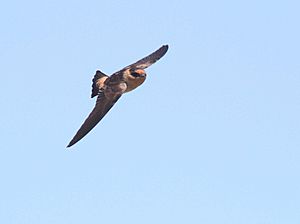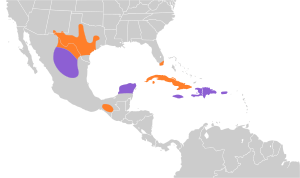Cave swallow facts for kids
Quick facts for kids Cave swallow |
|
|---|---|
 |
|
| Conservation status | |
| Scientific classification | |
| Genus: |
Petrochelidon
|
| Species: |
fulva
|
 |
|
The cave swallow (Petrochelidon fulva) is a medium-sized bird with a square-shaped tail. It's a type of swallow that lives in the Americas. These birds are known for building their nests and resting mainly in caves and sinkholes.
You can find cave swallows in Mexico and the Greater Antilles. Sometimes, they fly to the eastern and Gulf Coasts of the U.S. during fall and winter. They raise their young in places like southeastern New Mexico, Texas, Florida, the Greater Antilles, parts of southern Mexico, and along the west coast of South America. There are five different types, or subspecies, of cave swallows. Three live in North America, and two live in South America.
Contents
What Does a Cave Swallow Look Like?
A cave swallow is about 12 to 14 cm (5 inches) long and weighs around 19 g (0.7 ounces). The largest subspecies has wings about 10.7 to 11.2 cm long. The smallest subspecies has wings about 9.3 to 9.35 cm long.
Male and female cave swallows look very similar. It's hard to tell them apart just by their feathers. They have grey-blue feathers on their backs and brown-orange feathers on their foreheads and throats.
Understanding Cave Swallow Types
The cave swallow is a passerine bird, which means it's a perching bird. It belongs to the swallow and martin family, called Hirundinidae. The group Petrochelidon includes swallows and martins that often nest on cliffs. However, only the two South American subspecies of cave swallows prefer cliffs. The three North American subspecies like to nest in caves and sinkholes, which is why they are called "cave swallows."
There are five recognized subspecies of Petrochelidon fulva:
- The three North American types are P. f. fulva, P. f. pallida, and P. f. citata.
- These North American birds usually nest in natural caves and sinkholes. Sometimes, they also nest under human-made structures like highway culverts or bridges.
- They have larger wingspans than the South American types.
- P. f. fulva lives in the Greater Antilles and southern Florida.
- P. f. pallida is found in the southwestern United States and northeastern Mexico.
- P. f. citata lives farthest south in North America, on the Yucatán Peninsula of Mexico.
The two South American subspecies are P. f. aequatorialis and P. f. rufocollaris. These two are sometimes thought of as separate species because they live in different areas and choose different nesting spots. Instead of caves, they nest in open places like cliff faces and the sides of buildings.
- P. f. aequatorialis is found in Ecuador and might also live in Peru.
- P. f. rufocollaris lives in northwestern Peru.
- These two subspecies have smaller wingspans than their North American relatives.
Scientists are still studying these birds. Some data suggests that P. f. rufocollaris might actually be its own distinct species.
Where Cave Swallows Live and Nest
During the breeding season, the North American cave swallows (P. f. fulva, P. f. pallida, and P. f. citata) typically nest in caves, sinkholes, or human-made structures like highway culverts. The South American subspecies (P. f. aequatorialis and P. f. rufocollaris) prefer open areas like cliff faces and buildings.
Both types of cave swallows look for insects over open fields and water near their roosting (resting) spots. We don't know much about their spring and fall migrations. However, P. f. citata, P. f. aequatorialis, and P. f. rufocollaris stay in their breeding areas all year.
Where They Are Found
- P. f. pallida lives in the southwestern United States and northeastern Mexico.
- P. f. citata is found on the Yucatán Peninsula of Mexico.
- P. f. aequatorialis lives in Ecuador and possibly Peru.
- P. f. rufocollaris is in northwestern Peru.
Cave swallows are known to breed in Mexico, southeastern New Mexico, southern Florida, the Greater Antilles, and parts of Texas. Most populations in South America, Mexico, and the Caribbean stay in the same place year-round. However, populations in New Mexico and other northern areas fly south for winter. We don't know exactly where they go or how they get there. Cave swallows have been spending winters in southern Texas since the 1980s.
How Cave Swallows Behave
Cave Swallow Sounds
Baby cave swallows start making soft calls soon after they hatch. As they grow, their calls get louder. These calls help the chicks tell their parents what they need, like food.
Adult cave swallows make five main sounds: a song, a "che" note, and three types of chattering sounds.
- Their song usually lasts 3–4 seconds. It sounds like squeaks that turn into a "melodic warble" and end with double notes.
- A high-pitched, nasal "che" note is often used when predators are near the nest or when other birds fly by. It's the sound they make most often when away from their nest.
- The most common chattering sound is a "short, clear weet or cheweet."
- Another chattering sound is a "high-pitched che or chu note," often made in groups of 2 to 4 when predators are around.
- The least common chattering sound is a "lower pitched, clearer choo." They usually make this sound only when disturbed.
Cave swallows sing most often from March to August in Texas and New Mexico, which is their breeding season. They are usually loud around their nests but become quieter when they fly away.
What They Eat and How They Hunt
Cave swallows eat small to medium-sized flying insects throughout the day. They hunt in loose flocks over open areas, near plants, and against cliff faces. During nesting season, adult swallows prefer to hunt in the early morning and late afternoon. They catch many different insects, including grasshoppers and assassin bugs. They drink water while flying by skimming the surface of pools and rivers.
Nesting in colonies might help them find food. While there isn't much research on cave swallows specifically, studies on similar birds like cliff swallows suggest that colonies can act as "information centers." Swallows can learn from each other about good food sources. Cliff swallows have been seen following other birds from their colony to find food if they haven't been successful themselves.
Raising Young Cave Swallows
North American cave swallows nest mainly in caves and sinkholes. South American subspecies prefer open places like cliff faces and buildings. They breed between April and August. North American cave swallows are expanding their range because they are using more human-made nesting sites, like highway culverts and bridges. For example, in Texas, their breeding range grew by 898% between 1957 and 1999! Their populations are increasing by about 10.8% each year.
Cave swallows build open, cup-shaped nests from mud and bat guano (poop). They can reuse these nests for many breeding seasons. They also sometimes use old barn swallow nests and change them to fit their needs. Cave swallows and barn swallows often live together at nesting sites.
Cave swallows are social birds and like to nest in colonies of different sizes. They even share nesting sites with other swallow species, like barn swallows. This happens a lot in north central Mexico and more often in the United States as they use highway culverts. Sometimes, different species might interbreed, creating hybrids.
While using human-made nesting sites has helped cave swallows spread, it also has risks. Nests in culverts and bridges can flood more easily. The temperature can change a lot during breeding season, and there's a higher chance of sharing the site with other species or having predators. Also, there might be fewer nesting materials. Caves and sinkholes, however, have less risk of flooding, more stable temperatures, less sharing with other species, fewer predators, and plenty of nesting materials. Even with these risks, cave swallows nesting in culverts laid more eggs, had more eggs hatch, and had more babies survive than those in natural caves in one study. This might explain why their population is growing so fast even with riskier nest sites.
Eggs and Baby Birds
Cave swallow eggs are oval-shaped and usually white. They might have small spots of brown, lilac, or dull purple. A typical nest has three to five eggs. Both parents are thought to help keep the eggs warm. Only the female develops a special patch on her belly to warm the eggs.
When cave swallows hatch, they are altricial. This means they are born blind and cannot keep themselves warm. They stay in the nest until they can fly, which is about 20 to 22 days after hatching. Both parents feed the nestlings (baby birds) small insects all day. They will also defend the nest by swooping and calling loudly if there's a threat.
See also
 In Spanish: Golondrina pueblera para niños
In Spanish: Golondrina pueblera para niños


